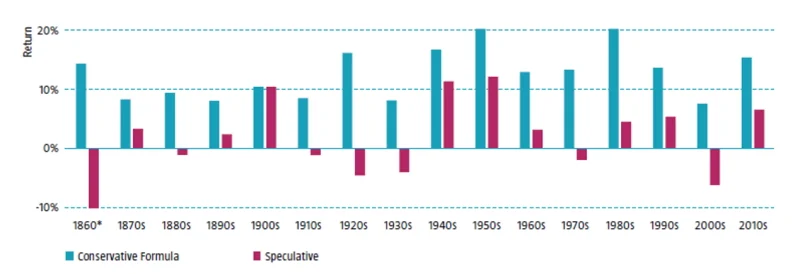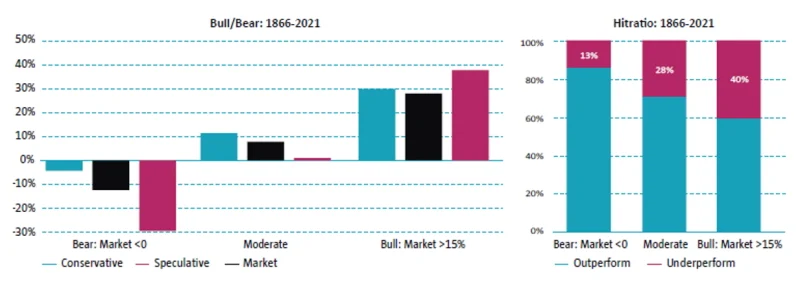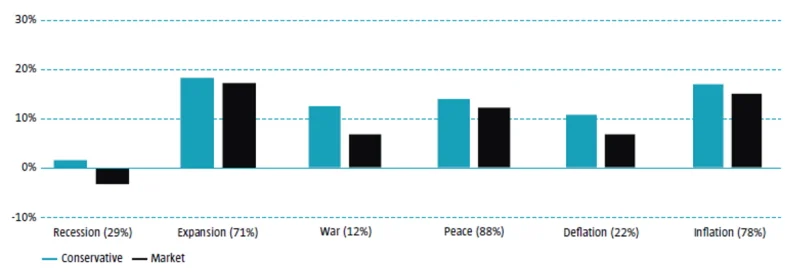Conservative strategies typically target market-beating long-term returns with lower downside risk by outperforming in down markets and broadly keeping pace in up markets. While the concept of a defensive approach clearly has its merits in an overall portfolio, it is important to test whether it holds up in practice.
In our recent study,1 we examined the performance of a simple rules-based conservative strategy over a period of more than 150 years (January 1866 to December 2021), using a novel US stock database created by Robeco researchers.2 This provided us with additional and unique insights given that the period before 1929 contained several boom-bust cycles, wars and periods of deflation.
For our investigation, we created low-risk or defensive strategies using an approach we term the ‘Conservative Formula’. This is based on a few rules:
From the largest 1,000 stocks, we select 500 with lowest volatility.
From this subset, we then choose 100 stocks with the best net-payout-yield and price momentum.
The resulting portfolio is then rebalanced on a quarterly basis.
By including net-payout-yield and price momentum, we create a more balanced defensive strategy that benefits from multiple alpha sources and avoids some of the pitfalls of low volatility investing, such as high valuations and weak momentum. This is also serves as a rough proxy for our Conservative Equities strategy.
Low-risk stocks outperform their high-risk peers
To begin with, we assessed how different portfolios sorted on volatility performed in the pre-1929 era and the entire sample period. Aside from the strategy based on the Conservative Formula, we used a ‘traditional’ low-risk approach by sorting the cross-section of stock returns into 10 portfolios on historical 36-month volatility. More specifically, the lowest decile portfolio contained stocks with the lowest volatility, while the highest decile portfolio contained stocks with the highest volatility.
As shown in Figure 1, the relationship between risk and return is negative over the 1866-1928 period as higher-risk portfolios underperformed their lower-risk counterparts. This means that taking additional risk on the stock market was not rewarded. The picture is broadly similar over the full sample period, albeit returns initially increase along with risk, before trending down again as the volatility increases. In general, this informs us that taking on more risk is not necessarily rewarded in the long run.
Figure 1 | Portfolios sorted on volatility

Source: Robeco Quantitative Research. Performance in USD gross of fees and costs.
Meanwhile, the portfolio based on the Conservative Formula generated higher-risk adjusted returns than the single-sorted volatility strategies. This was expected, given the integration of additional return factors. Over both sample periods, the average annualized return is about 2% to 3% higher than the three lowest-volatility portfolios, with similar volatility to the second and third-lowest volatility portfolios.
As such, the Conservative Formula leads to a defensive, high-return strategy as opposed to a minimum volatility portfolio. This is important in the context of achieving stable capital growth in the long run.
Get the latest insights
Subscribe to our newsletter for investment updates and expert analysis.
Conservative stocks fare better than their speculative counterparts
We also investigated how a portfolio based on the Conservative Formula performed in each decade (except for the 1860s as our data only started in 1866), alongside a portfolio (speculative) on the opposite side of the spectrum, i.e., consisting of high volatility stocks with low net-payout yields and weak momentum. As depicted in Figure 2, conservative stocks delivered a positive annualized return in every decade, whereas their speculative counterparts achieved more mixed results. Moreover, conservative stocks beat their speculative peers in all periods.
Figure 2 | Annualized return of conservative and speculative stocks per decade

Source: Robeco Quantitative Research. Performance in USD gross of fees and costs.
Winning by losing less
As outlined earlier, defensive strategies typically achieve their long-term outperformance by preserving capital in down markets and participating meaningfully in up markets, i.e., they win by losing less in the long run. As illustrated in Figure 3, conservative stocks provided some downside protection during bear markets and kept up during bull markets over the full sample period. By contrast, their speculative peers outperformed during bull markets; however, this did not compensate for their losses during bear markets.
Figure 3 | Conservative Formula, speculative stocks and the market portfolio across bull/bear markets

Source: Robeco Quantitative Research. Performance in USD gross of fees and costs.
That said, it is important to note that while conservative stocks typically reduce losses in sell-off events, there are times when they do lag in bear markets. Indeed, the hit ratio for conservative stocks in bear markets over our sample period is 87%, which means that they delivered worse returns than the market over 13% of the time in down markets. To mention a few instances, we saw this play out during the start of the Spanish flu pandemic in 1917, the ‘panic of 1873’, and more recently, during the early phases of the Covid pandemic in 2020.
But as outlined, the conservative strategy reduced losses in most bear markets, and in the long run, it shows its true strength as the unexpected short-term periods of underperformance in down markets are effectively canceled out.
Active Quant: finding alpha with confidence
Blending data-driven insights, risk control and quant expertise to pursue reliable returns.
Resilience during recessions, wars, and deflation
Our deep 155-year sample also gave us the opportunity to study infrequent macro events. For instance, we have only seen a handful of recessions over the last 30 years, but they were quite common in the 19th century. Similarly, there are not many wartime periods we can reference in recent history, but over our sample period there were seven US wars – starting with the Spanish-US war and ending with the Iraq-US war. Inflationary episodes were also more common back then compared to the last 30 years (excluding 2021 onwards). As shown in Figure 4, conservative stocks have generally exhibited resilience in periods that coincided with recession, expansion, peace, war, deflation or inflation.
Figure 4 | Conservative Formula and the market portfolio across regimes: 1866 to 2021

Source: Robeco Quantitative Research. Performance in USD gross of fees and costs.
Conclusion
Given our findings, we conclude that conservative, low-risk stocks typically provide stable and high long-term returns as they ‘win by losing less’. Their attributes of preserving capital in down markets and participating meaningfully in up markets are key ingredients for long-term capital growth.
Thanks to the results seen over the long sample period dating back to the 19th century, we believe it is highly unlikely that the high alpha generated by conservative stocks is down to luck. In fact, the approach works across different time periods and market structures. In our view, this means that the low-risk anomaly is not dependent on a specific regime or market environment. Therefore, we believe the case for a long-term strategic allocation to conservative stocks remains strong.
Footnotes
1 See: Baltussen, G., Van Vliet, B. P., and Van Vliet, P., May 2022, “150+ years of conservative investing: winning by losing less”, Robeco article.
2 See: Baltussen, G., Van Vliet, B. P., and Van Vliet, P., November 2021, “The cross-section of stock returns before 1926 (and beyond)”, working paper.


















